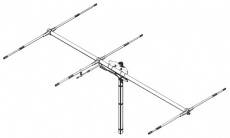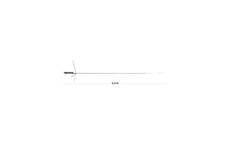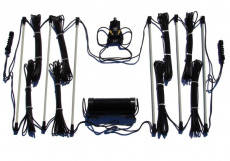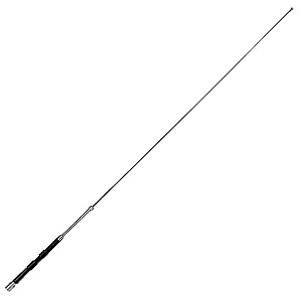HF Antennas
- further categoriesIf your goal is to buy a shortwave antenna with durable quality and excellent functionality, the DND Telecom online shop has everything you need to buy a product that really fits your needs. We have HF antennas in a wide range of categories, versions and types to suit your expected usage. Read more...
• Type: 1/4λ ground plane
• Frequency range: tunable 40-70 MHz
• Impedance: 50Ω
• Radiation (H-plane): 360° omnidirectional
• Radiation (E-plane): beamwidth @ -3 dB = 86°
• Radiation angle: 0°
• Polarization: linear vertical
• Gain: 0 dBd, 2.15 dBi
• Bandwidth @ SWR ≤2: ≥3.7 MHz @ 40 MHz
• SWR @ res. freq.: ≤ 1.2 @ start freq.
• Max. Power (CW) @ 30°C: 1000 Watts
• Connector: UHF-female
• Type: 3 Elements Yagi
• Frequency range: 50-54 MHz (tunable)
• Impedance: 50Ω
• Radiation (H-plane): beamwidth @ -3 dB = 93°
• Radiation (E-plane): beamwidth @ -3 dB = 60°
• Polarization: Linear Horizontal
• Gain: 6.4 dBd - 8.5 dBi
• Bandwidth @ SWR 1.5: ≥ 1.0 MHz @ 50.5 MHz
• SWR @ res. freq: ≤ 1.2
• Front to back ratio: 20 dB
• Max. Power (CW) @ 30°C: 600 Watts
• Connector: UHF-female
• Type: 5 Elements Yagi
• Frequency range: 50-54 MHz (tunable)
• Impedance: 50Ω
• Radiation (H-plane): beamwidth @ -3 dB = 72°
• Radiation (E-plane): beamwidth @ -3 dB = 54°
• Polarization: Linear Horizontal
• Gain: 8.4 dBd - 10.5 dBi
• Bandwidth @ SWR 1.5: ≥ 1.4 MHz @ 50.5 MHz
• SWR @ res. freq: ≤ 1.2
• Front to back ratio: 25 dB
• Max. Power (CW) @ 30°C: 600 Watts
• Connector: UHF-female
• Frequency: 3-30 Mhz (with antenna tuner)
• Impedance: 50Ω
• VSWR: ≤ 3.3
• Maximum power rating: 250 W (PEP)
• Length: 6.4 m
• Weight: 800 g
• Connector: UHF-female
• Type: Self support 5 band trapped vertical antenna with trapped radials. Radial elements can be set for one direction.
• Frequency: 7/14/21/28/50MHz
• Impedance: 50Ω
• VSWR: ≤ 1.5:1
• Maximum power rating: 200W SSB(7MHz), 400W SSB (14/21MHz), 500W SSB
• Maximum wind resistance: 45m/sec
• Length: 3.6 m
• Radial length: 1.8 m
• Weight: 3.4 kg
• Mounting mast: Ø 30-62 mm
• Connector: UHF-female
• Type: Self support 6 band trapped vertical antenna with trapped radials.Radial elements can be set for one direction
• Frequency: 3.5/7/14/21/28/50MHz
• Impedance: 50Ω
• VSWR: ≤ 1.5:1
• Maximum power rating: 200W (PEP)
• Maximum wind resistance: 40m/sec
• Length: 4.6 m
• Radial length: 1.8 m
• Weight: 4.9 kg
• Mounting mast: Ø 30-62 mm
• Connector: UHF-female
• Frequency: 3.575 - 3.650 Mhz
• Length: 1.8 m
• Weight: 0.7 kg
• Frequency: 3.650 - 3.725 Mhz
• Length: 1.8 m
• Weight: 0.7 kg
• Type: Two section co-linear ground plane antenna
• Frequency: tunable 50-54MHz
• Impedance: 50Ω
• VSWR: ≤ 1.5:1
• Bandwith: 2 Mhz nominal for less than 2.0:1 VSWR
• Maximum power rating: 200W (FM), 500W (SSB)
• Maximum wind resistance: 35m/sec
• Gain: 5.5 dBi
• Length: 6.8 m
• Weight: 2.7 kg
• Mounting mast: Ø 30-62 mm
• Connector: UHF-female
• Type: dipole
• Frequency: 2-30 MHz
• Impedance: 50Ω
• VSWR: ≤ 2:1 from 2-18Mhz, 3:1 above 18Mhz
• Maximum power rating: 150W (PEP)
• Length: 25 m
• Coaxial feedline: 30m (5D-2V) supplied with PL-259 plug
• Type: dipole
• Frequency: 2-28.6 MHz
• Impedance: 50Ω
• VSWR: ≤ 2:1 from 2-18Mhz, 3:1 above 18Mhz
• Maximum power rating: 150W (PEP)
• Length: 10 m
• Coaxial feedline: 30m (5D-2V) supplied with PL-259 plug
• Frequency: 28(29)/50 MHz
• Type: 28MHz - 5/8 λ; 50MHz - 2 x 5/8 λ
• Impedance: 50Ω
• Maximum power rating: 200W (FM), 500W (SSB)
• Maximum wind resistance: 35m/sec
• Gain: 28MHz - 3.4dBi; 50MHz - 5.5 dBi
• Length: 6.8 m (MAX)
• Weight: 2.9 kg
• Mounting mast: Ø 30-62 mm
• Connector: UHF-female
• Frequenci: 50-54 MHz (6m)
• Type: 1/4 λ
• Maximum power: 250 W
• Gain: 2.15 dBi
• Length: 1 m
• Weight: 130 g
• Connector: PL dugó
• Frequenci: 28 MHz (10m)
• Type: 1/4 λ
• Maximum power: 250 W (SSB)
• Gain: 0 dBi
• Length: 1.10 m
• Weight: 180 g
• Connector: PL dugó
The advantages of shortwave antennas
These antennas mostly transmit in the range between 3-50 MHz. The frequencies immediately below HF are called the medium frequency (MF) band, while the next band of higher frequencies is called the very high frequency (VHF) band. The advantages of shortwave over longwave transmission are that lower power transmitters can be used, shortwave is less sensitive to atmospheric disturbance and equipment costs are lower. HF antennas can communicate over distances of 3000 km or more.
Radio networks require minimal infrastructure. As such, it is often the only reliable means of communication in the event of a disaster. Government and private organizations are constantly looking for the most flexible, reliable and cost-effective solutions for their remote, emergency and security communications needs. While HF radio will never replace landlines or mobile phones, it is an irreplaceable wireless communications tool for emergency, remote and military communications organizations. HF radio is simple and quick to install. Fixed base stations can be used to communicate with other bases or to control mobile (vehicle mounted) and portable (manpack) users in the field.
History of shortwave antennas
In the 1920s and 30s, the potential for long-range transmission of short waves was recognised. New horizons were opened up in radio broadcasting and radio communication. The first shortwave stations were built and shortwave broadcasting in specific frequency bands was launched.
Applications of HF antennas:
- HAM antennas
- Shortwave broadcasting
- Municipal communications
- Sea, maritime communications
- Military, diplomatic communications
- About the types of shortwave antennas available in our webshop
Basically, there are two categories of shortwave antenna types available in our range. One is the group of shortwave automotive antennas and the other is the category of shortwave base antennas. For the latter, you can choose between Sirio or Diamond devices.
The DND Telecom webshop offers a wide range of shortwave antennas
In the first instance, all you have to do is click on the name of the one of the three categories that is a realistic option to purchase. Then, within each category page, we can choose which type of shortwave antenna best serves our needs. As an extra help, we have given you the relevant parameters for each type that may be important when making your choice. This makes it easy to compare the antennas without a single click. The most useful way to do this is to look at the most important parameters of the available types in relation to the expected use of the HAM antenna. For example, the value of the frequency range, the specific factors of the radiator or gain, and the maximum power.
Related services for purchasing a shortwave antenna
It is important to note that through the DND webshop, it is not only possible to purchase equipment in perfect working order, but also to choose additional services on demand. For example, in addition to the shortwave base antennas, you can request a standardisation review of the lightning protection system or the preparation of lightning protection design documentation, including the installation and repair of the lightning protection system or the installation of the base roof antenna. These additional options can be an added benefit over and above the purchase of a shortwave antenna.
What frequencies does the shortwave antenna support?
A wide range of Sirio and Diamond shortwave antennas are available in the DND Telecom webshop. Each antenna has different characteristics and therefore the frequency range it supports is very wide. Let's look at the details. The frequency range of the directional yagi base antenna is between 50 and 54 MHz. In addition, this antenna is tunable. The Diamond base antenna transmits between 3 and 30 MHz, but there are some that use a frequency band of 3.5/7/14/21/28/50 MHz, but the radial CP6 antenna uses a frequency band between 3.575 and 3.650 MHz, the shortwave multiband antenna uses a frequency band between 28 or 29 and 50 MHz, and the Diamond brand shortwave car antenna uses a frequency band between 28 MHz or 50 and 54 MHz.
What is the effective range of a shortwave antenna?
As mentioned above, shortwave antennas have a huge range, covering distances of up to 3000 kilometres with ease. This type of antenna is also favoured by professionals because it can modulate a signal for thousands of kilometres and is not hampered by geographical obstacles. This is also due to the fact that short-wave long-distance links are established exclusively by skywaves.
But there is also the earthwave. This makes the issue of the effective range of shortwave antennas worth splitting in two. Why is this necessary? Because the earth is a poor conducting medium for short waves, meaning that surface waves suffer very strong attenuation, and at a distance of 10 kilometres the signal is so weak as to be almost useless. By contrast, so-called sky waves propagate perfectly in the ionosphere. Waves reflected from the ionosphere therefore have a high signal strength. This is why it is possible to communicate perfectly with another antenna from a distance of up to 3000 kilometres.
What materials are shortwave antennas made of?
To the layman, shortwave antennas are simple steel rods. However, experts call the materials that antennas are made of ferrite. Shortwave antennas, on the other hand, must be made of ferrite made of NiZn material to ensure proper performance.
What are the directional or omnidirectional characteristics of a shortwave antenna?
As there are many shortwave antennas, they have different radiation directions. As a consequence, its characteristics must be evaluated separately in each case, although it can be said that the so-called stick antennas have omnidirectional characteristics. These include car antennas or the versions of base antennas that end in a rod. Of course, these antennas have 360-degree omnidirectional characteristics, which are called omnidirectional antennas by the experts. But there are also yagi base antennas, which in turn have directional radiation characteristics. Available from the DND Telecom web store, these types of base antennas have characteristics of 93 or 72 degrees for H-panels and 60 or 54 degrees for E-panels.
Does the shortwave antenna have a built-in amplifier or signal booster function?
Any VHF base shortwave antenna that has a gain feature is available in the DND Telecom web store. The values of this signal amplifier function can be, for example, 6.4 dBd and 8.5 dBi or possibly 8.4 dBd and 10.5 dBi.















